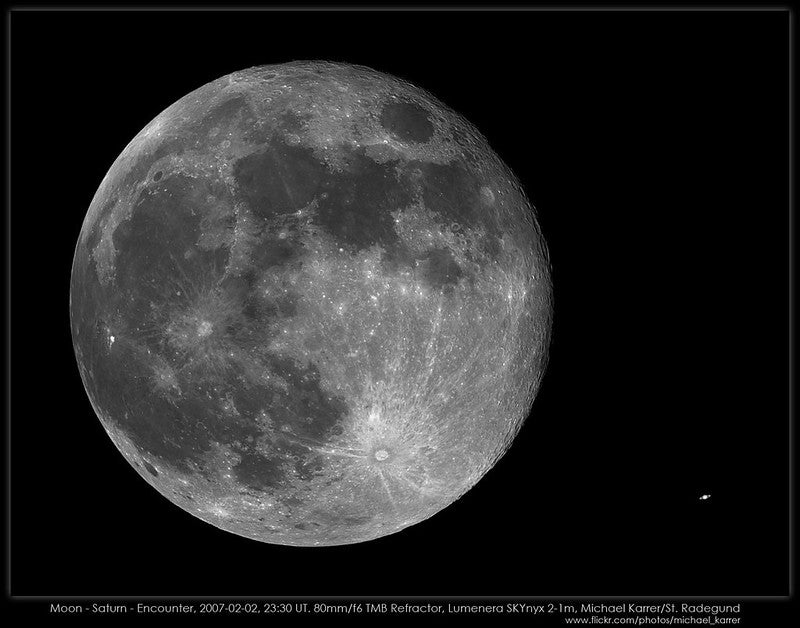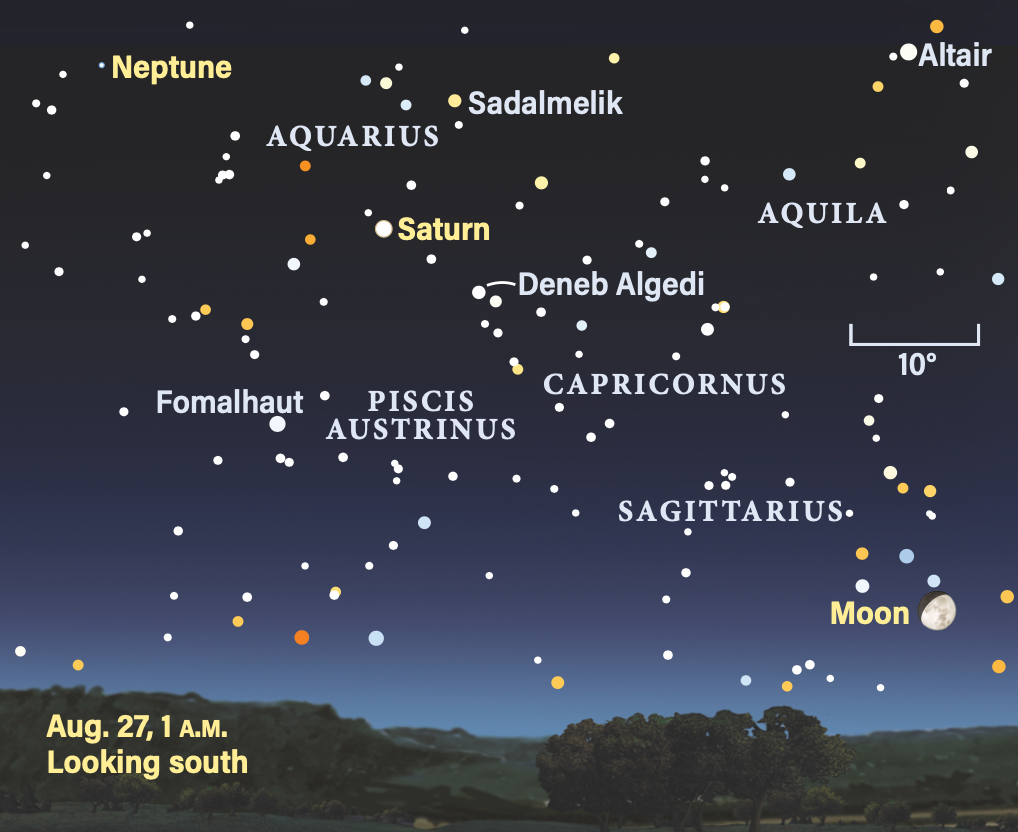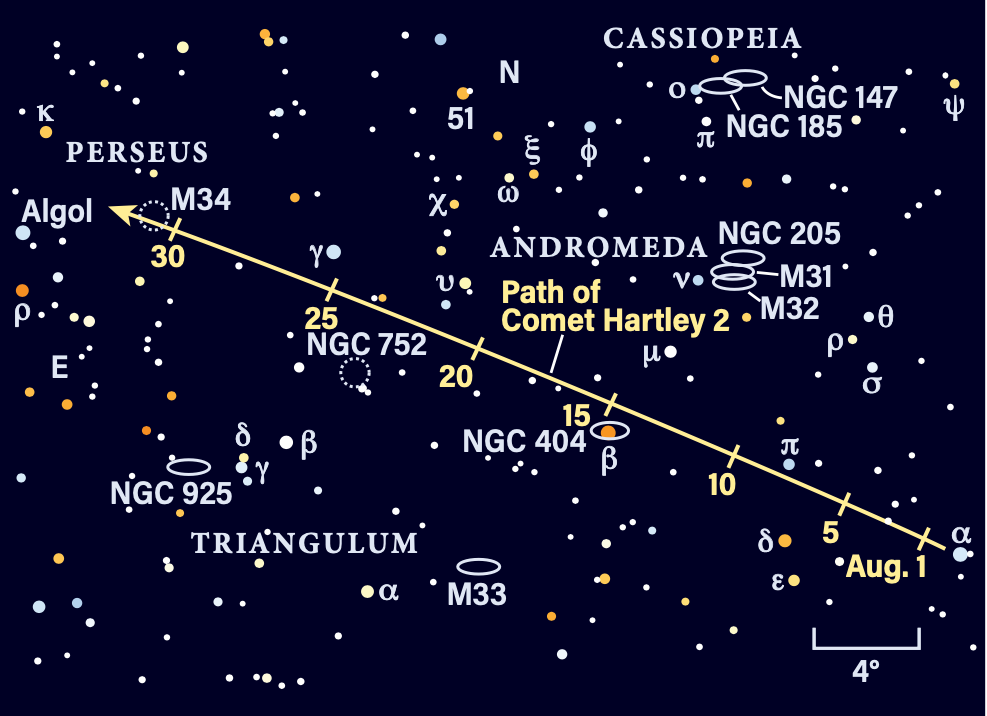
Friday, August 25
The Summer Triangle is now slowly setting in the evening as its eponymous season draws to a close. The brightest star in this large asterism is magnitude 0 Vega, which still stands 85° above the southern horizon two hours after sunset. We can use this bright star as a jumping-off point to find the Ring Nebula (M57), a planetary nebula of glowing gas blown off by a dying star. This famous object was recently photographed at infrared wavelengths by the James Webb Space Telescope.
You’ll find the Ring about 6.6° southeast of Vega; you can also simply slide some 0.8° east-southeast of magnitude 3.5 Sheliak (Beta [β] Lyrae) to land on our target. The Ring glows at magnitude 8.8, requiring some form of magnification to enjoy. Binoculars will show it as simply a fuzzy, slightly larger-than-expected star. It takes a telescope to show the Ring’s true nature: a denser circular structure of material surrounding a lighter, hazy center. At the very middle is the object responsible for the nebula: a 15th-magnitude white dwarf. The entire nebula spans a little under 1.5′ at its widest. Although astronomers once thought it was spherical, they now believe it is indeed ring-shaped, perhaps resembling a slightly squished doughnut.
The region of sky we’re looking at is relatively far from the waxing Moon, but the best views will still come starting around local midnight and later into tomorrow morning. By then, our satellite has set and the sky is much darker, but Lyra remains relatively high above the turbulent air near the horizon.
Sunrise: 6:21 A.M.
Sunset: 7:43 P.M.
Moonrise: 3:45 P.M.
Moonset: —
Moon Phase: Waxing gibbous (64%)
*Times for sunrise, sunset, moonrise, and moonset are given in local time from 40° N 90° W. The Moon’s illumination is given at 12 P.M. local time from the same location.
Saturday, August 26
Up for an early-morning challenge to kick off the weekend? There’s a new, brightening cometary player on the scene: C/2023 P1 (Nishimura). Discovered less than two weeks ago, this dusty iceball is making its way toward a close approach with the Sun in less than a month. It’s currently mid-8th magnitude and expected to brighten even further, potentially reaching naked-eye magnitudes in mid-September.
Nishimura is located in far western Cancer, right near its border with neighboring Gemini. This region is visible in the hour or two before sunrise — the longer you wait, the higher above the eastern horizon it will be, but the brighter the sky will become as well. You can find Nishimura by dropping down (east) about 4.3° from magnitude 3.6 Kappa (κ) Geminorum. See if you can spot it with binoculars; if not, a small scope should do it. Stay tuned — we’ll be sure to follow this comet as it continues to brighten on its one and only journey through the inner solar system.
Look closer to the horizon, and you may also catch sight of the Beehive Cluster (M44) in the middle of Cancer, rising about two hours before the Sun. Although the cluster will be difficult to observe when it is closest to the horizon, its sparkling stars should remain visible — especially through optics — even as the sky begins to lighten. Just make sure, as always, to put away telescopes or binoculars well before sunrise from your location, which may differ from the time given below.
Sunrise: 6:22 A.M.
Sunset: 7:41 P.M.
Moonrise: 4:51 P.M.
Moonset: 12:38 A.M.
Moon Phase: Waxing gibbous (74%)

Sunday, August 27
Today is the big day: Saturn reaches opposition at 4 A.M. EDT in the constellation Aquarius. Shining at magnitude 0.4, its light dominates the Water-bearer’s sparse western regions; the nearest bright star is nearly 20° to Saturn’s south: magnitude 1.2 Fomalhaut in Piscis Austrinus.
You can certainly catch the planet at the moment of opposition, when it is about 30° high in the southwest. Or you can wait until evening, when the gas giant rises around sunset and climbs higher as the sky grows dark. The best time to observe it is in the hour or so around local midnight.
Through a telescope, Saturn’s disk now spans 19″, while its magnificent rings are 43″ across and tilt about 9° relative to our line of sight. There are three rings typically seen through telescopes: the outer, dusky A ring; an inner, brighter B ring, separated from the A ring by the Cassini Division; and the gauzy, innermost C ring. The planet is also wreathed with numerous moons, the brightest of which — magnitude 8.5 Titan — lies about 3′ due east of the planet on the 27th. Inner moons such as 10th-magnitude Dione, Rhea, and Tethys move over the course of a matter of hours. Tethys and its shadow, nearly overlapping thanks to our current point of view, transit the planet’s southern regions from about 11 P.M. EDT on the 27th to 12:51 A.M. EDT on the 28th (still late on the 27th in all time zones farther west).
Asteroid 8 Flora also reaches opposition at 4 A.M. EDT today, shining at magnitude 8.4 and also in Aquarius. In fact, you can use brighter Saturn as a signpost. Regardless of whether you’re observing in the early morning or later at night, simply find the ringed planet and drop about 6.3° south-southeast with binoculars or a telescope to home in on the main-belt world. As an added bonus, Flora is just over 3° north-northeast of the stunning Helix Nebula (NGC 7293), an 8th-magnitude planetary nebula reminiscent of the Ring we observed earlier this week. We’ll make sure to come back to this pair early next month as well, when Flora passes a tad closer to the Helix in early September.
Sunrise: 6:23 A.M.
Sunset: 7:40 P.M.
Moonrise: 5:50 P.M.
Moonset: 1:40 A.M.
Moon Phase: Waxing gibbous (84%)
Monday, August 28
Uranus stands stationary against the background stars of far southeastern Aries at 11 P.M. EDT tonight. You’ll find it about halfway between the bright planet Jupiter, also in Aries, and the unmissable Pleiades star cluster (M45) in Taurus.
The best time to view the scene is early, rather than late — if possible, aim for the hour or two before dawn, when it is high in the southern sky. The familiar winter constellations of Taurus and Orion are also visible at this time, with most of Canis Major above the horizon as well.
The distant ice giant is located 3° due south of 5th-magnitude Tau (τ) Arietis, in a field of view relatively devoid of bright stars. Uranus’ 4″-wide disk glows at magnitude 5.8, rendering it a perfect target for binoculars or any small scope. See if you can identify its slightly greenish-blue hue. It will appear as a disklike, “flat” star compared to any other pointlike suns in its vicinity. After today, the planet will begin moving retrograde, or westward, relative to these background stars.
Jupiter, now magnitude –2.6, lies about ¼° east of magnitude 5.5 Sigma (σ) Arietis — don’t confuse the star for one of the Galilean moons, although Callisto lies just east of this star early this morning. Much closer to the planet are Io (also west) and Europa (east, close to the planet) and Ganymede (farther east).
Sunrise: 6:24 A.M.
Sunset: 7:38 P.M.
Moonrise: 6:37 P.M.
Moonset: 2:53 A.M.
Moon Phase: Waxing gibbous (92%)
Tuesday, August 29
In the early-morning hours after midnight, mighty Cetus the Whale is rising in the east. The constellation’s alpha star, magnitude 2.5 Menkar, lies some 11° south of bright Jupiter, which dominates the adjacent constellation Aries.
But our target isn’t Menkar — it’s Kaffaljidhma, also cataloged as Gamma (γ) Ceti. This magnitude 3.5 star sits just under 5° west of Menkar and is not one star, but three. Through a telescope, you’ll spot two stars just 2.8″ apart: brighter Gamma Cet A (magnitude 3.6) and fainter Gamma Cet B (magnitude 6.3). You may be able to discern their different hues, often described as blue and yellow — though this is mostly an optical illusion, as the stars are roughly the same temperature and color, with only a slight difference between them. It takes these two suns some 320 years to circle each other, with a physical distance some 70 times the average Earth-Sun separation between them.
Where is the third star in this system? It’s quite far, nearly ¼° northeast of the main pair and glowing a meager magnitude 10.6. Gamma Cet C is so far from the other two —21,000 Earth-Sun separations away — that it takes more than a million years to orbit them! Astronomers suspect it may someday become unbound from the system altogether, while the inner two stars will remain a close binary throughout their evolution into white dwarfs.
Sunrise: 6:25 A.M.
Sunset: 7:37 P.M.
Moonrise: 7:16 P.M.
Moonset: 4:13 A.M.
Moon Phase: Waxing gibbous (97%)
Wednesday, August 30
The Moon reaches perigee, the closest point to Earth in its orbit, at 11:54 A.M. EDT. At that time, our satellite will sit 221,942 miles (357,181 kilometers) away. Two hours later, the Moon passes 2° south of Saturn at 2 P.M. EDT; less than 8 hours after that, at 9:36 P.M. EDT, our satellite’s phase reaches Full. Because this is the second Full Moon in a single month, it is called a Blue Moon. And because this phase occurs when our satellite is also closest to Earth, it appears slightly larger than average in the sky and is also known as a Super Moon.
When it is Full, the Moon rises directly opposite the Sun, so you’ll notice the Full Moon slipping above the horizon right at Sunset. It will appear big and brigh, particularly when close to the horizon. As it rises, it may appear to get slightly smaller (our satellite often appears largest near the horizon, where your brain has nearby earthly objects for comparison) but will remain bright as the sky continues to darken. Saturn is now to the Moon’s upper right. See if you can pick it up.
You might remember that August’s first Full Moon was also a Super Moon. And, in fact, September’s Full Moon will also be a Super Moon, as the Moon’s orbital motion lines up with this phase one last time. That will be the last Super Moon of the year, while this month’s Blue Moon is the only time two Full Moons will take place in the same month of 2023.
Sunrise: 6:26 A.M.
Sunset: 7:35 P.M.
Moonrise: 7:49 P.M.
Moonset: 5:35 A.M.
Moon Phase: Full

Thursday, August 31
Comet 103P/Hartley 2 is passing practically through the outskirts of the open cluster M34 in Perseus today. This region is rising after sunset and highest in the overnight hours, so if you can stay out late to observe it around midnight or later, your view will improve.
Let’s start by finding M34. This magnitude 5.5 cluster spans just over half a degree and is less than 200 million years old. It lies just over 1° west-northwest of 2nd-magnitude Algol in Perseus, near that constellation’s western border with Andromeda. Even at low magnifications, you can resolve M34’s fuzzy glow into bright stars, making it an excellent target to observe with any size instrument. Comet Hartley 2 is currently magnitude 12, so its greenish glow will be more difficult to pick out amid the moonlight brightening the sky. Still, it’s worth it for a glimpse of the comet floating just ½° east of the cluster’s center overnight. If you can, try to snap a few astrophotos as the two pose together in the sky.
Hartley 2 is a short-period comet that returns to our skies every 6.3 years. It is expected to brighten over the next two months, potentially reaching 7th magnitude as it nears perihelion — the closest point to the Sun in its orbit — in mid-October.
Sunrise: 6:26 A.M.
Sunset: 7:34 P.M.
Moonrise: 8:16 P.M.
Moonset: 6:55 A.M.
Moon Phase: Waning gibbous (99%)
Friday, September 1
The now-waning Moon passes 1.4° south of Neptune at 3 A.M. EDT. You’ll find the pair high in the southern sky at that time, just to the lower left of the Circlet of Pisces. This asterism, or unofficial grouping of stars, within the larger constellation Pisces the Fish contains seven stars in total: 19, Gamma, 7, Theta (θ), Iota (ι), Lambda (λ), and Kappa Piscium. Gamma, at magnitude 3.7, is the brightest.
Neptune is the most distant planet in our solar system; as such, despite its large size, it appears both small and faint from our vantage point here on Earth. You’ll need binoculars or a telescope to see its tiny, 2″-wide disk, which glows at magnitude 7.7. The planet sits just 16″ northeast of magnitude 5.5 20 Psc today. If you return to the region each night over the next week or so, you’ll see the planet moving southwestward each day, until it stands 4′ due north of 20 Psc on the 10th.
Sunrise: 6:27 A.M.
Sunset: 7:32 P.M.
Moonrise: 8:42 P.M.
Moonset: 8:13 A.M.
Moon Phase: Waning gibbous (96%)

Sky This Week is brought to you in part by Celestron.









